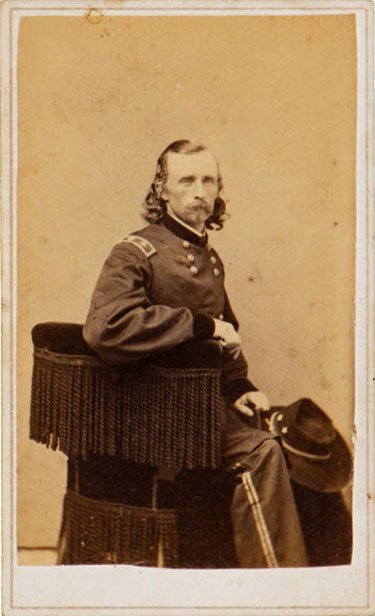
George Armstrong Custer, Carte de Visite by Goldin. Taken in May 1865, just after the conclusion of the war. Custer was in Washington for the Grand Review celebration.
Tom Slater, in the latest Heritage email, introduces the upcoming June 9th GEORGE ARMSTRONG CUSTER AND THE PLAINS INDIAN WARS Auction at Heritage Auctions:
For Garryowen And Glory!
Those were the prophetic closing words of the regimental song of George Armstrong Custer’s 7th Cavalry. As a boy growing up in the days of black-and-white TV my favorite “old movie” was They Died with their Boots On, starring the incomparable swashbuckler Errol Flynn as G. A. C. I watched it countless times. Who could forget the catchy tune played over and over during the film, or the image of Custer, the last man standing, blazing away, six-gun in each hand, as he was ridden down by a horde of Indians? Eventually I would have to unlearn most of the contrived “history” related in the movie, but my disillusionment did little to discourage my fascination with the saga of Little Bighorn and Custer’s Last Stand.
Barely 200 men perished with Custer, a seemingly insignificant number when compared to the tens of thousands of casualties in other American battles. Why does the Little Bighorn saga still hold such fascination nearly a century and a half later? Undoubtedly, part of the allure lies in the fact that Custer was a genuine American hero long before the events of 1876. The youngest man to be made general during the Civil War, he was famous for his exploits as a cavalry commander — as well as for his golden locks and flamboyant dress. After finishing dead last in his West Point class, Custer certainly made his mark. During the decade before Little Bighorn he led the 7th Cavalry as they fought Indians and explored new territory with the Yellowstone and Black Hills Expeditions. By the time of the disastrous battle in 1876 he was a celebrity and a household name.
Further adding to the drama was the possibility that personality traits and conflicts played a role. Was Custer brash and irresponsible in rushing to attack the large Indian encampment, or was he simply acting on what he thought was reliable military intelligence? Was the failure of Capt. Frederick Benteen to come to Custer’s aid a sound military decision, or was he influenced by his well-known personal distaste for his commander? Was Major Reno’s retreat after initially assaulting the village an example of cowardice, or an unavoidable response in the face of unanticipated, overwhelming resistance?
Lastly, there was the epic significance of a number of Plains tribes and bands coming together for one last, great celebration of their vanishing way of life, and to make a final valiant stand against the inevitable encroachment of “civilization.” It is now known that the Indian camp was aware of the soldiers’ approach, but failed to scatter as had been their tactic in the past. Rather they waited almost passively for the great confrontation, knowing full well that, even if they managed to win the battle, they had already lost the war.
It is our great honor to bring to you on June 9th an amazing auction focused on those historic events and the personalities associated with them, titled “George Armstrong Custer and the Plains Indian Wars.” We are especially gratified to present the important artifacts and relics amassed by Glenwood J. Swanson, the highly respected Custer collector and scholar whose items make up a large portion of the auction. Glen is particularly appreciated for his ongoing support of archeological endeavors at the Custer Battlefield and for his landmark book, G. A. Custer His Life and Times, published in 2004. Lavishly illustrated, largely with items from his own collection, this book gives wonderful insights into Little Bighorn and the men who fought there.





jim
Custer, still a better role model then many of today’s role models.
Frank
Certainly many of the Indians were savages, but many in the military were no better. We put soldiers in Leavenworth now for things that Custer routinely did then. Just as he did in the Civil War, he made war on civilians, women, and children. At Little Big Horn, he ran into a bigger population than he had ever massacred before. Benteen followed orders and stayed where he was. Reno did what you do when you kick over a hornets nest, run.
ed in texas
Plus, that Colonel Custer (he had to accept a demotion after the Civil War ended in order to stay in the Army) had already been court martialed a few years before, but managed to skate.
He had been given the assignment to “patrol the west”. He had left his wife and family in St Louis, and set off. When news of a cholera epidemic there reached him, he decided that this was a matter that required investigation.
And took the Seventh Cal. with him.
What got him past the court martial was the St Louis is indeed on the western side of the Mississippi, so he had technically not violated orders.
Please Leave a Comment!